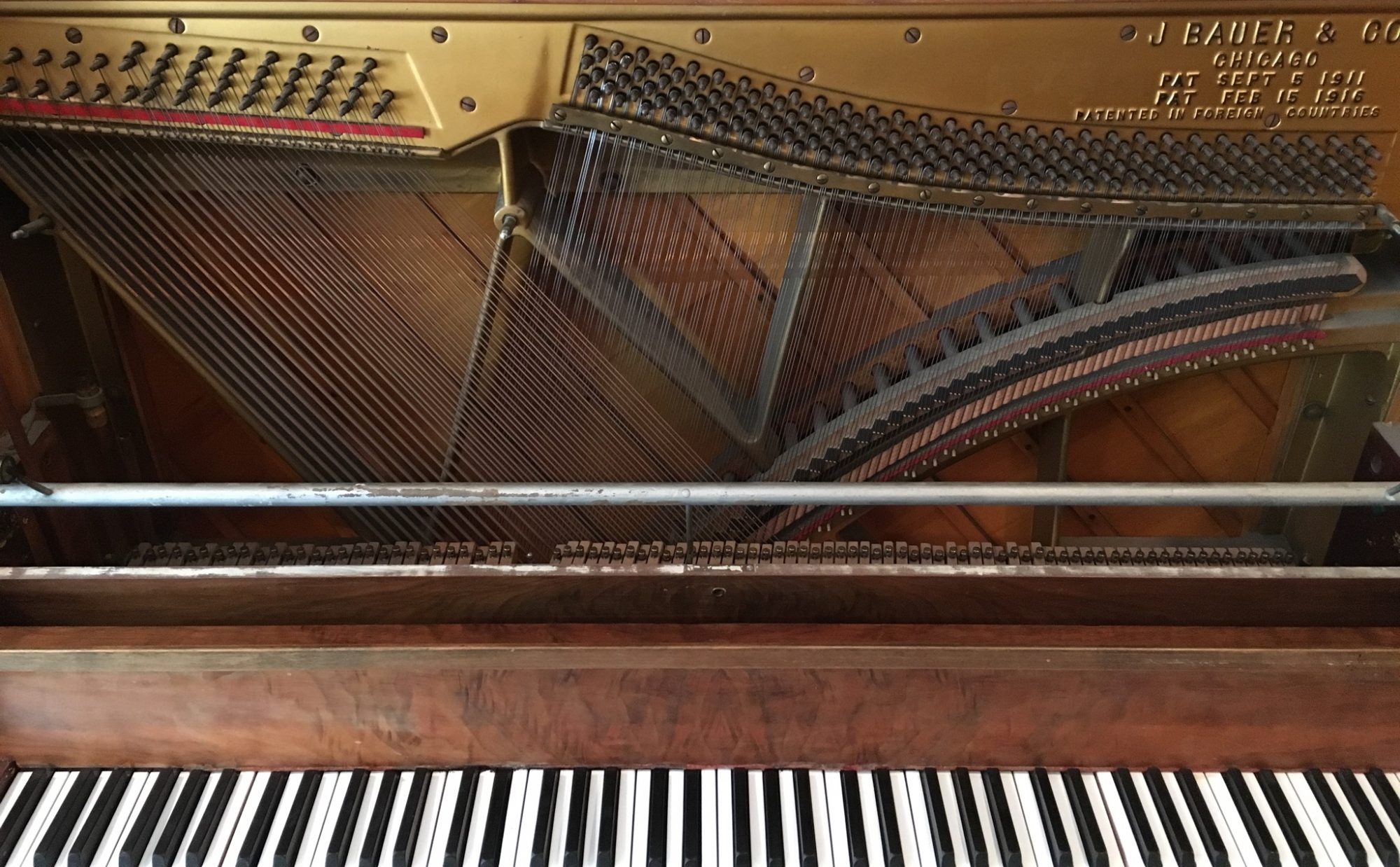As students of music, how do we effectively focus our thoughts as we sail the vast oceans of sound? Let’s consider the idea of breaking songs down into smaller parts, which I will call song anatomy.
Recognizing song anatomy puts wind in our sails and guides the efficiency of our practice time.
Written Music as a Guide
At the beginning of a transcribed piece of music, two main components are labeled as signatures: the time signature and the key signature. I plan to create separate posts diving into these topics more deeply, but wanted to use these two ideas as the foundation for this discussion.
Time signature (rhythm)
The time signature defines the song’s rhythmic aspect, consider it an X-axis (horizontal).
Key signature (scales)
The key signature designates the (do-re-mi) scale used, the Y-axis (vertical).
Song Anatomy: Rhythm and Pitched Scales
I suggest we chunk information always keeping in mind the anatomy of a song while we study music. So I’d like to share with you my breakdown of the parts that deserve the greatest attention: rhythm (the beat) and pitched scales (the melody, chords, and bass).
Two Wheels:
Let’s think of music’s sound as the two wheels of a bike:
- Back wheel = rhythmic feel
- Front wheel = pitched scales
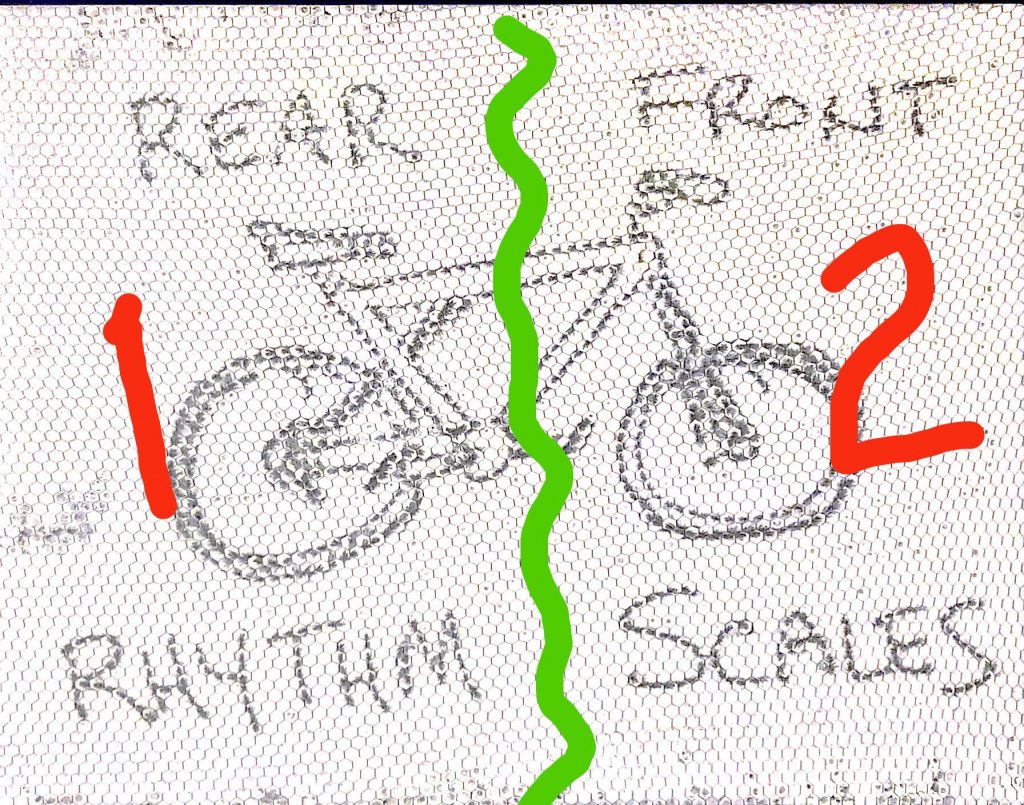
Rhythm: driver
I think rhythm is the most crucial element to master, so let’s start there.
Rhythm is the song’s driving force, the part that enables motion, the heartbeat.

Performing rhythm well is what separates entertainment from the a-rhythmic sound of practicing. This is the case at every ability level: beginner to master.
There are 4 rhythmic subjects I’d like us to discuss: tempo, meter, note values, and feel.
Tempo
Tempo is measured as beats per minute (bpm)…how fast or slow the beats of a song are counted.
So 60 bpm is one count per second (slow). 120 bpm would be two clicks per second (dancy).
105 bpm = moderate walking pace
Meter
Meter refers to a standard way musicians collectively count a song.
Most American (and Western) genres count to 4 repeatedly.
Each numbered count is called a beat.
A 4/4 time signature, the most popular, means that four quarter notes complete a measure.
Note Values
Notes: sound for a specific time.
Rests: silence for a specific time.
Types
Whole, half, quarter, and eighth are the top tier note values.
Sixteenth, thirty-second, sixty-fourth, and so on, are smaller beat subdivisions.

All note/rest types can occur in triplet form.
All note/rest types can occur with dots following, which elongate (for an additional half of the value of the note attached to).
Feel (or Placement)
I use the word feel to help us become the best we can possibly be!
From a dry aspect we can consider swing vs. a straight feel.
But another angle I think adds extreme personality to individual players is their attention to note placement.
By note placement I mean the precision of where a musician places every single note in relation to each beat: late, on the beat, or early.
Now let’s discuss the front wheel of the bike: pitched scales.
Scales
Song anatomy could be defined many ways… For this study, let’s consider four elements that I think all music students should master to make meaningful music: rhythm, melody, chords (and accompaniment), and bass (the root).
Music students... Always know which part of the anatomy: 1) you are trying to conquer 2) is causing your rhythm to hiccup 3) to break down and focus on conquering the hiccup
Four Song Anatomy Elements
- Melody = The main event, the head
- Chords = The accompaniment, the torso
- Bass = The foundation, the footing
- Rhythm = The beat, the dance, the flow

Rhythm is not a part of this image!
1) Melody
Think of the melody as the main event in song anatomy, the primary attraction. Melody is almost always experienced as one note at a time (one voice singing the part).

Melody can be thought of as the part where a singer sings lyrics in pop music, or where violins carry the tune in orchestral music.
A melody also tends to breathe and not be a run on sentence (unless you’re experiencing Bach.)
In the image above, you can see that Beethoven used repetition, the initial 3 notes of his famous 5th Symphony, come to a conclusion on a different note: tension and resolve.
Motion: 4 Types of Intervals
Motion is a journey: the rise and fall of a melody–like a boat bobbing over waves.
An interval is the distance between two notes. For instance, when you travel from Do to Re, that interval is called a 2nd because only 2 scale positions are used. But the interval is a 3rd when you travel from Do to Mi, because there is a total of 3 positions including the note skipped (Re).
Reading notation, written notes on a staff, the reader follows the dots moving in the following distances/intervals up or down:
- Same–the following note doesn’t ascend or descend
- Steps–2nds (two letters involved)
- Skips–(3rds, 4ths, 5ths) … (3rds=three letters involved)
- Leaps–(6ths, 7ths, octaves)
1) Same
“Same” means there is no motion, or that the note stays the same: repetition. Let’s take a 2nd look at this motion type in Beethoven’s initial 3 notes, which stay on the same line.

2) Steps
Steps are the most common type of motion mostly because they are the easiest to sing.
Masterful composers and songwriters (from Bach to Beethoven to the Beatles) use this as their dominant motion choice.
Let’s look at an example of stepwise motion:
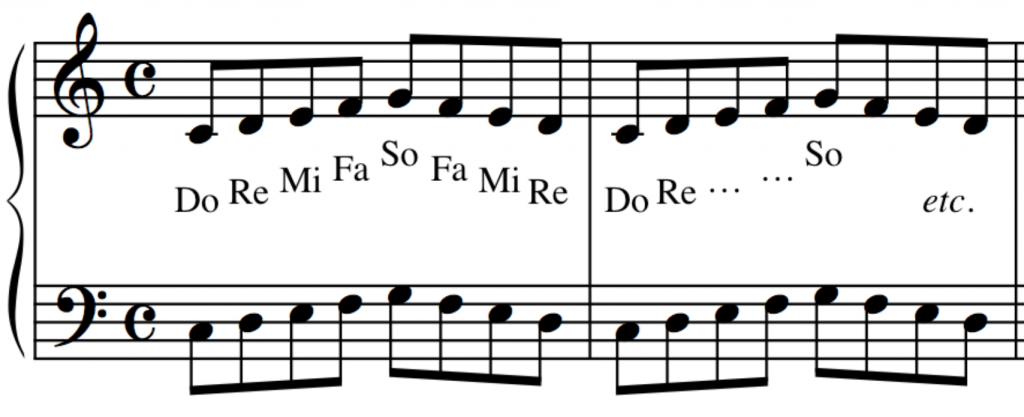
Each note head is changing positions: from a line to a space, to a line to a space. If you play connect the dots, you should see each note head either moving up one position or down one position.
3) Skips
Beethoven uses a skip in the 5th Symphony introduction: the 3rd note to the final 4th note in the image displays a note head skipping from the 2nd line down to the 1st line. Describing the motion as a skip means that it is skipping over a space.

4) Leaps
Leaps are very large melodic jumps, which are challenging to sing!
A popular example of a leap is the interval an octave (aka an 8th).
The melody in “Somewhere Over the Rainbow” uses an octave leap at the moment you sing the two ascending notes for the chorus lyric “Some-where.”


link back up to Four Anatomy Elements
2) Chords
Chords sound as multiple notes at once—harmony—and are generally used to embellish the melody.
Emotional Results of Harmony
When we put two or more notes together, the outcome affects us emotionally: (in basic terms) positively or negatively.
Dissonance and resolution are more appropriate terms to describe these two possibilities:
- Dissonant—agitation needing to go somewhere, sounding incomplete
- Resolved—home, smooth, stable, a satisfactory completion
Harmony occurs as different types. Let’s distinguish 3 ways to put harmony together (there are many more ways, but this will get us started):
- Dyads—2 vertical notes
- Triads—3 vertical notes
- Triad plus Extensions—4 or more vertical notes
Dyad
Two notes sounding simultaneously creates a dyad.
Guitarists (and piano players) use dyads in the form of power chords (5ths). On the chart below, the P5 is the “perfect 5th,” which is the same as a power chord.

According to studies going back to the Renaissance, the “perfect” harmonies, known as consonant sounds, start with the P above, which stands for “perfect.”
The “U” fits into that category (“u” meaning unison, meaning two voices singing the same pitch/note).
The other dyads with the upper and lower case “m” have a more colorful sound than the perfect intervals.
- Upper case M = Major
- Lower case m = minor
The following intervallic harmonies are examples that display dissonant sound:
- 2nd
- 7th
Triad
Three notes written vertically and played simultaneously.
Most common form looks like a snow man (3rds). Look out for this combination as it is a particular grip on both the guitar and piano.
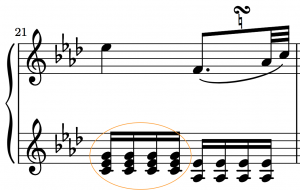
Triad + extension
Most common form is a 7th chord.
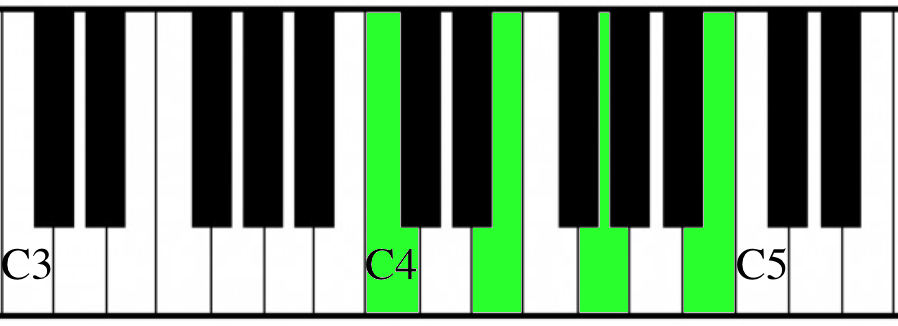
The green notes show the every-other-note grip that is typical to a triad and its extension.
7th chords come in different types. The following are the most popular:
- Minor 7th
- Dominant 7th
- Major 7th (the type shown above in green)
For the purposes of this simpler tutorial, I will get into more triad + extensions concepts in other posts.
Block chords vs. Arpeggios
So far, I’ve only discussed vertical harmony…but it can also be experienced melodically as well. Played this way you will hear the notes of the chord one followed by the next like a melody.
link back up to Four Anatomy Elements
3) Bass
We usually experience bass as one deep note at a time (as opposed to chords).
Bass is the foundation of song anatomy—the low end of pitched frequencies. It provides a thumping of sound that can actually be physically felt.

Sound waves travel slower on the lower frequency spectrum, which means there is more time between each wavelength.
Typically, bass notes occur one at a time creating a fuller sound underneath the melody and supporting chords.
I generally think of bass as notes below Middle C. So on an 88 note keyboard, that is a little less than half of the notes! But the main range for bass is between E1 – G3 (though it can go beyond those extremes).
The left hand on the piano is generally responsible for playing bass notes.

link back up to Four Anatomy Elements
4) Rhythm
Lastly, I think rhythm is the most important quality in music. Though I already described rhythm at the top of this post, I find it to be so important that I wanted to finish on that note once again.
In the song anatomy, rhythm intertwines with the pitched elements (melody, chords, bass) like the vascular system in our bodies.
Rhythm is the element that makes us dance! It’s exciting and a motivator.
Counting to 4 repeatedly is the most common meter for songs. It is possible to count to other numbers: 2, 3, 6, 9, and 12 are used pretty regularly in Classical music.
Once you start over, the part you completed is called a measure.
I will make other posts just focusing on the details of rhythm!
I’ve given a brief description already at the top of this post.
link back up to Four Anatomy Elements
I hope you enjoyed my simple thoughts regarding song anatomy!
Check out my website:
